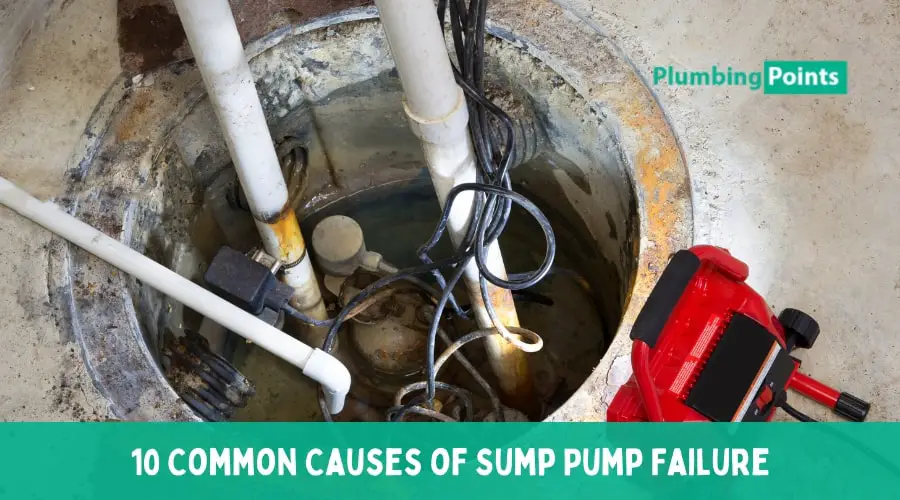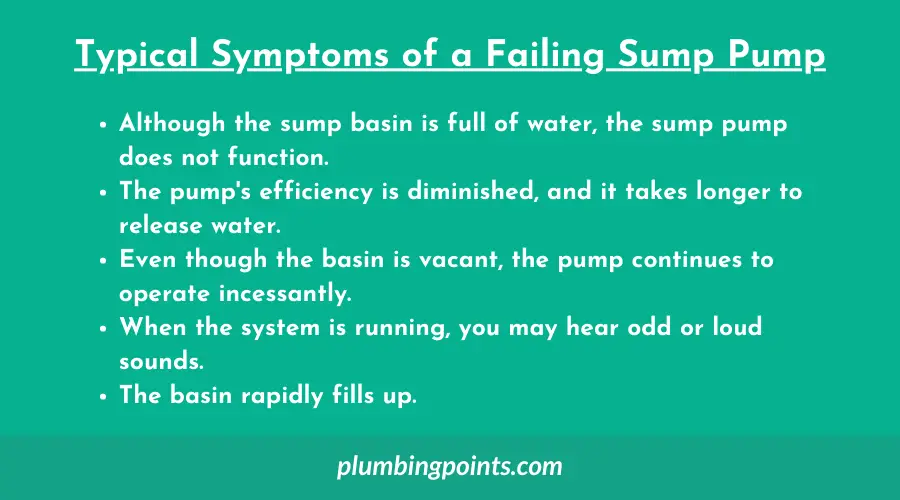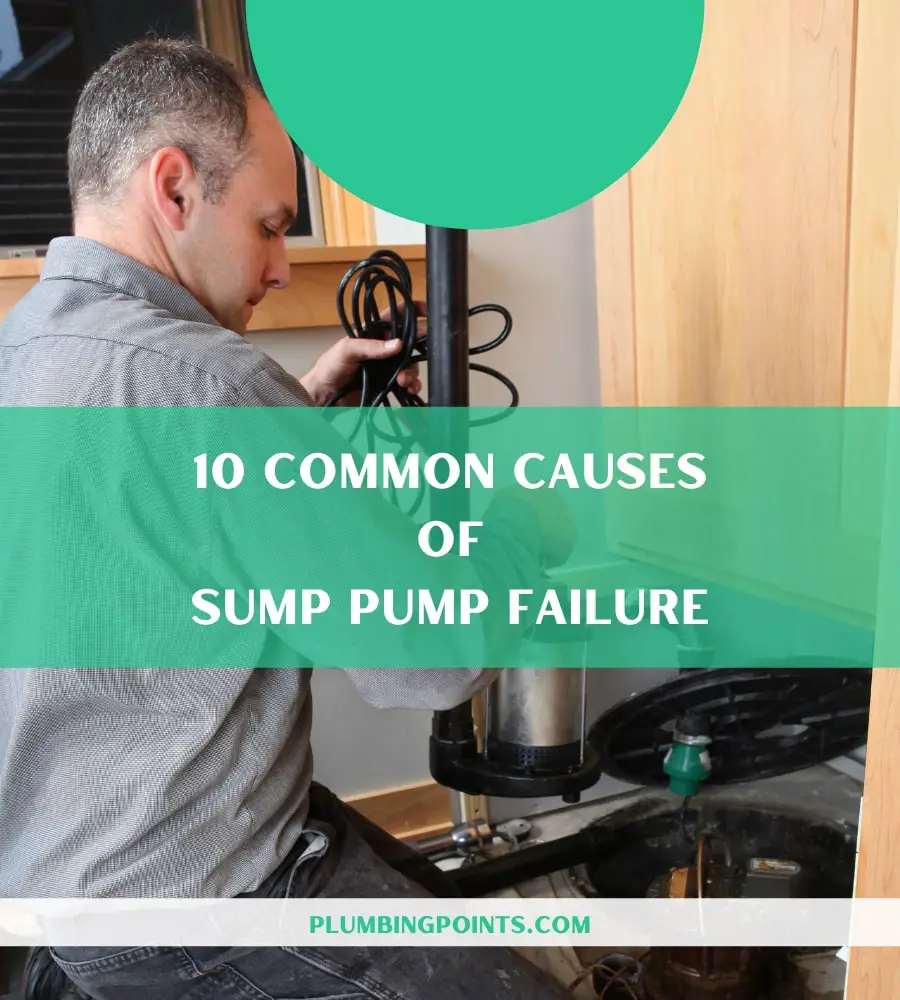Last Updated on August 28, 2022 by admin
Adding a sump pump to your property might be a terrific investment. They help avoid basement flooding, safeguard you from sewage overflow, and may even raise the value of your home if they are installed correctly. As with most things, they have the potential to go wrong. When a sump pump fails, it does the harm it was designed to prevent, but what leads it to malfunction?
Sump pump failures may be prevented if you know the root reasons of the problem. As a result, the article outlines 10 common causes of sump pump failure.

Table Of Contents
- 1 Typical Symptoms of a Failing Sump Pump
- 2 Sump Pump Failure Reasons
- 2.1 1. Issues with the Switch
- 2.2 2. Excessive Use of Sump Pump
- 2.3 3. Pump Exhaustion
- 2.4 4. Electricity Disruptions
- 2.5 5. Drainage Pipe Blocked or Frozen
- 2.6 6. Blocked Sump Pump
- 2.7 7. Dysfunction as a Result of Aging
- 2.8 8. Installation Error or Sump Pump Size Discrepancy
- 2.9 9. Disrupted Drainage Network
- 2.10 10. Neglecting to Maintain
- 3 Why Failed Sump Pump?
- 4 Conclusion
Typical Symptoms of a Failing Sump Pump
- Although the sump basin is full of water, the sump pump does not function.
- The pump’s efficiency is diminished, and it takes longer to release water.
- Even though the basin is vacant, the pump continues to operate incessantly.
- When the system is running, you may hear odd or loud sounds.
- The basin rapidly fills up.

Sump Pump Failure Reasons
This problem is prevalent, particularly if the sump pump is not properly maintained. Sump pump issues may have a wide range of reasons, but a sequential repair guideline can help you narrow down the possibilities. The reasons behind this are outlined below:
1. Issues with the Switch
A defective or blocked switch is among the most prevalent reasons for a broken sump pump. Sump pumps are typically controlled by one of two mechanisms: a pressure sensor or an electrically operated float switch.
As with the second scenario, the pump’s float might get trapped and refuse to move, despite when the water level rises around it. Consequently, the float activator arm will not flick the switch on, resulting in a pump that is not activated. Debris may build up in the basin, preventing the float from moving freely and consequently preventing the switch from working properly.
2. Excessive Use of Sump Pump
It’s easy for your sump pump to get fatigued in various scenarios. When the sump pump fails due to overloading, this is a typical cause.
An overflow of water. If your sump pump isn’t strong enough to cope with floods or severe rains, it may not be able to handle the volume of water that is generated. This problem may be resolved by improving your sump pump or by using several devices.
3. Pump Exhaustion
Overworking a pump may quickly lead to its failure if you don’t minimize its workload. In normal circumstances, a sump pump only runs when necessary. Yet, during floods or severe rains, it may run continuously. If such is the case, the pump is likely to fail.
The sump pump should be strong enough to manage the amount of water entering the pit to prevent this problem. Additionally, inspect whether the pump only operates when there is water inside the sump hole.
4. Electricity Disruptions
Although it may seem apparent, checking the power source should be one of the primary things you check if your sump pump ceases operating. Blackouts may occur at any time, but they are most common during big storm surges when you require the sump pump the most.
Occasionally a power outage is limited to a single area of your house rather than the whole building. As a result, it’s always a smart option to double-check that the outlet into which the device is connected is operational. An emergency generator can keep your sump pump running even if the power goes out for an extended period of time. Your basement will not flood in the event of a power outage caused by a strong storm or other disasters.
5. Drainage Pipe Blocked or Frozen
A blocked or frozen output line is the underlying source of sump pump problems in many cases. Flowing from the sump bowl to an external location, the outlet pipe drains all of the water out of the sump basin. If this pipe becomes blocked, the whole system becomes inoperable, and water begins to gather in the cellar.
Drainage pipes may get blocked with debris such as pebbles, rats, mud, plants, and other organic matter. Keeping your sump pump’s tubing clean is critical to its performance; otherwise, it won’t operate.
6. Blocked Sump Pump
There’s a good risk that dirt will soon collect in your sump pit without a lid, causing your system to back up. When in doubt about whether or not your sump pump is blocked, disconnect it and do a visual inspection of the apertures. To view properly, you’ll need a torch. Remove anything that is obstructing the intake.
The pump will get blocked again sooner than expected if you do not remove the dirt and sediment from the sump basin.
7. Dysfunction as a Result of Aging
There is no such thing as a permanent state of existence. There are a number of things that might go wrong with your sump pump over time, such as deterioration of the rotor and other elements.
A plumbing professional may occasionally do miracles, but if your sump pump is older than 10 years, it’s possible that you’ll be better off changing your old system with a brand new one instead.
8. Installation Error or Sump Pump Size Discrepancy
To prevent sump pump breakdowns, ensure that the pump is installed correctly. The manufacturer’s directions should be implemented at all times throughout the installation of any item.
There should be a checking valve in the discharge line to restrict water from reentering the sump basin. This valve is required for most sump pump types to function correctly. Having a filthy or insufficiently sized sump pit is another prevalent problem. Float switches may get jammed, or the device’s lifetime might be reduced as a result.
9. Disrupted Drainage Network
You can’t expect your sump pump to do its job correctly unless you have a well-functioning underground drainage network. By virtue of gravity, the sump pit receives water that has been collected.
It’s possible to have a functional pump and yet not be able to remove water from your home’s drainage system. Therefore, if your sump pump appears to be operating properly but you still have flooding in your basement, you should have your drainage line inspected.
10. Neglecting to Maintain
Maintaining your sump pump properly may increase its life by a large margin. On the other hand, a lack of upkeep has the opposite effect.
Always keep an eye out for any problems with your sump pump and make any necessary repairs or adjustments if they are warranted. The manufacturer’s instructions should be read before applying it. If you’re not into do-it-yourself projects, you may hire someone to do it for you instead.
A blocked pipe or equipment or a congested float switch may be blamed if you haven’t kept up with routine maintenance in the last several months.
Why Failed Sump Pump?
Conclusion
In most cases, sump pump failure goes unnoticed until it happens to you. Having a sump pump in your house is more important than you believe. You can expect water damage to your house at some point. Among the reasons for this is a lack of information on basic ways to keep your cellar from leaking. Learning the Top Common Causes of Sump Pump Failure will be beneficial in the future.
Share on Pinterest

